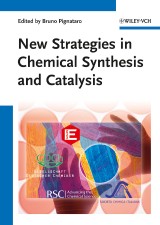Details

New Strategies in Chemical Synthesis and Catalysis
1. Aufl.
|
120,99 € |
|
| Verlag: | Wiley-VCH |
| Format: | EPUB |
| Veröffentl.: | 24.09.2012 |
| ISBN/EAN: | 9783527645848 |
| Sprache: | englisch |
| Anzahl Seiten: | 406 |
DRM-geschütztes eBook, Sie benötigen z.B. Adobe Digital Editions und eine Adobe ID zum Lesen.
Beschreibungen
This volume represents one of the two edited by inviting a selection of young researchers participating to the European Young Chemist<br> Award 2010. The other volume concerns the area of Nanotechnology/Material Science and is titled: Molecules at Work.<br> This book contains the contributions of selected young chemists from the field of synthetic chemistry. The contributions are grouped<br> under the three following umbrella topics:<br> <br> Synthetic Methods<br> Catalysis<br> Combinatorial and Chemical Biology<br> <br> This volume is an indispensable read for all organic and inorganic chemists, biochemists, chemists working with/on organometallics,<br> and Ph.D. students in chemistry interested in seeing what tomorrow's chemistry will look like.
PREFACE<br> <br> PART I: Synthetic Methods<br> <br> ELECTROSPRAY AND CRYOSPRAY MASS SPECTROMETRY: FROM SERENDIPITY TO DESIGNED SYNTHESIS OF SUPRAMOLECULAR COORDINATION AND POLYOXOMETALATE CLUSTERS<br> Introduction<br> Background to ESI-MS<br> Application of High-Resolution ESI-MS and CSI-MS toPolyoxometalate Cluster Systems<br> Species Identification and Probing Structural Transformations in Multi-Metallic Systems<br> Future Challenges and Conclusions<br> <br> EFFICIENT SYNTHESIS OF NATURAL PRODUCTS AIDED BY AUTOMATED SYNTHESIZERS AND MICROREACTORS<br> Efficient Synthesis of Natural Products Aided by Automated Synthesizers<br> Continuous-Flow Synthesis of Vitamin D3<br> Conclusions<br> <br> CHEMOSELECTIVE REDUCTION OF AMIDES AND IMIDES<br> Introduction<br> Reduction of Tertiary Amides<br> Reduction of Secondary Amides<br> Dehydration of Primary Amides<br> Reduction of Imides<br> Conclusion<br> <br> IONIC OZONIDES -<br> FROM SIMPLE INORGANIC SALTS TO SUPRAMOLECULAR BUILDING BLOCKS<br> The Forgotten Oxygen Anion<br> The Synthesis of Ionic Ozonides<br> The Structural Variety of Ionic Ozonides<br> Magnetic Properties<br> Conclusions and Perspectives<br> <br> CHEMISTRY AND BIOLOGICAL PROPERTIES OF AMIDINOUREAS: STRATEGIES FOR THE<br> SYNTHESIS OF ORIGINAL BIOACTIVE HIT COMPOUNDS<br> Amidinoureas: an Introduction<br> Amidinoureas in Chemistry<br> Synthetic Strategies for the Preparation of Amidinoureas<br> Macrocyclic Amidinoureas<br> Perspectives<br> <br> PART II: Catalysis<br> <br> DNA CATALYSTS FOR SYNTHETIC APPLICATIONS IN BIOMOLECULAR CHEMISTRY<br> Introduction<br> In vitro Selection of Deoxyribozymes<br> Scope of DNA-Catalyzed Reactions<br> Synthetic Applications of RNA-Cleaving Deoxyribozymes<br> DNA-Catalyzed Linear Ligation of RNA<br> DNA-Catalyzed Synthesis of 2',5'-Branched Nucleic Acids<br> DNA-Catalyzed Synthesis of Nucleopeptide Conjugates<br> Mechanistic Aspects of DNA Catalysis<br> Conclusions and Outlook<br> <br> IRON-CATALYZED CSP3 -<br> H OXIDATION WITH H2O2: CONVERTING A RADICAL<br> REACTION INTO A SELECTIVE AND EFFICIENT SYNTHETIC TOOL<br> Introduction and Scope<br> Environmentally Benign C -<br> H Oxidation<br> Inspiration from Nature<br> Mechanistic Considerations<br> Bioinspired C -<br> H Oxidation Catalysts<br> Perspectives<br> <br> HYDROGEN BONDS AS AN ALTERNATIVE ACTIVATION<br> Introduction<br> Thiourea Catalysts<br> Conclusions<br> <br> ELECTROSYNTHESIZED STRUCTURED CATALYSTS FOR H2 PRODUCTION<br> Introduction<br> Preparation of Structured Catalysts<br> Electrosynthesis<br> Electrosynthesis of Hydrotalcite-Type Compounds<br> Summary and Outlook<br> <br> MICROKINETIC ANALYSIS OF COMPLEX CHEMICAL PROCESSES AT SURFACES<br> Introduction<br> Time and Length Scales in Heterogeneous Catalysis<br> Hierarchical Multiscale Approach for Microkinetic Model Development<br> Show Case: Microkinetic Analysis of CH4 Partial Oxidation on Rh<br> <br> Conclusions<br> <br> SYNTHETIC POTENTIAL BEHIND GOLD-CATALYZED REDOX PROCESSES<br> Introduction<br> Gold-Catalyzed Reactions Involving Oxygen Functionalities<br> Gold-Catalyzed Reactions Involving Nitrogen Functionalities<br> Gold-Catalyzed Reactions Involving C -<br> C Bond Formation<br> Gold-Catalyzed Reactions Involving Alkene Difunctionalization<br> Gold-Catalyzed Reactions Involving Halogen Functionalities<br> Summary and Outlook<br> <br> TRANSITION-METAL COMPLEXES IN SUPPORTED LIQUID PHASE AND SUPERCRITICAL FLUIDS -<br> A BENEFICIAL COMBINATION FOR SELECTIVECONTINUOUS-FLOW CATALYSIS WITH INTEGRATED PRODUCT SEPARATION<br> Strategies for Catalyst Immobilization Using Permanent Separation Barriers<br> Supported Liquid-Phase Catalysts Based on Organic Solvents (SLP)<br> Supported Aqueous-Phase Catalysts (SAP)<br> Supported Ionic Liquid-Phase Catalysts (SILP)<br> Supported Liquid-Phase Catalysts and Supercritical Fluids<br> Conclusion<br> <br> PART III: Combinatorial and Chemical Biology<br> <br> INHIBITING PATHOGENIC PROTEIN AGGREGATION: COMBINATORIAL CHEMISTRY IN COMBATING ALPHA-1 ANTITRYPSIN DEFICIENCY<br> Introduction<br> a1-Antitrypsin Deficiency<br> Targeting the s4A Site with the Peptide Annealing Method<br> Expanding the Molecular Diversity<br> Characterization of the Combinatorially Selected Peptide<br> Conclusion and Outlook<br> <br> SYNTHESIS AND APPLICATION OF MACROCYCLES USING DYNAMIC COMBINATORIAL CHEMISTRY<br> Supramolecular Chemistry<br> Dynamic Combinatorial Chemistry<br> Ion Transport across Membranes Mediated by a Dynamic Combinatorial Library<br> <br> TOWARD TOMORROW'S DRUGS: THE SYNTHESIS OF COMPOUND LIBRARIES BY SOLID-PHASE CHEMISTRY<br> Introduction<br> Solid-Phase Synthesis of Selected Privileged Structures<br> Conclusions and Outlook
Bruno Pignataro, born in Bologna in 1972, is Professor of Physical Chemistry at the University of Palermo. He received his degree in chemistry in 1995 from the University of Catania and his PhD in materials science five years later. He has helped establish a wide network of international collaborations and organized several scientific activities at national and international level, including coordinating the Young Chemists Group of the Italian Chemical Society and chairing the first three editions of the European Young Chemist Award. Professor Pignataro's group research focus on the fields of nanoscience and nanotechnology, molecular electronics, and biotechnology.
This volume represents one of the two edited by inviting a selection of young researchers participating to the European Young Chemist<br> Award 2010. The other volume concerns the area of Nanotechnology/Material Science and is titled: Molecules at Work.<br> This book contains the contributions of selected young chemists from the field of synthetic chemistry. The contributions are grouped<br> under the three following umbrella topics:<br> <br> Synthetic Methods<br> Catalysis<br> Combinatorial and Chemical Biology<br> <br> This volume is an indispensable read for all organic and inorganic chemists, biochemists, chemists working with/on organometallics,<br> and Ph.D. students in chemistry interested in seeing what tomorrow's chemistry will look like.

















